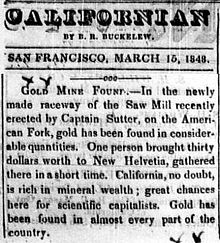
The Californian was the first California newspaper.

The Californian was the first California newspaper.
The Californian was first published in Monterey, California on August 15, 1846, [1] by Alcalde Walter Colton and his friend Robert B. Semple, from a well-used Ramage printing press that Agustín V. Zamorano brought from Hawaii to Monterey in 1834. [2] Zamorano used it to print books, letterheads and proclamations, but not a newspaper. [3] When Commodore Robert F. Stockton arrived in Monterey with the American naval invasion in July 1846, he found the printing press stored in the Custom House and notified Colton. [3]
The paper Colton and Semple printed on was cigarette paper, [4] the only kind available in quantity. The single-sheet publication was printed on a series of 11.75 by 10.25 in (30 by 26 cm) sheets, [2] with English on one side and Spanish on the other. [2] The biggest news item in the first edition was the United States declaring war on Mexico. [4] On October 3, 1846, The Californian printed the first poem published in a California periodical, entitled "On Leaving the United States for California". The next issue carried the poetical rejoinder "On Leaving California for the United States". Both poems were unsigned, but were probably the same author. [5]
The Californian moved to Yerba Buena, as San Francisco was then called, in mid-1847. The city was about to undergo rapid changes as the California gold rush got underway. The newspaper did not report about the discovery of gold because word spread so quickly from person to person. The Californian was forced to shut down May 29, 1848, because its entire staff had departed for the gold fields. Its rival newspaper, the California Star run by Mormon Samuel Brannan and Edward C. Kemble, suspended publication for the same reason on June 14.
Both The Californian and the California Star were bought in 1848 and their printing equipment was combined into one publication, the Alta Californian . [2] Finding that one printing press was sufficient, the older press from Monterey was moved by Kemble to Sacramento to print the Placer Times beginning in April 1849. [2] Kemble wished to preserve the press in a museum, but sold it to an Englishman, H. H. Radcliffe, who used it in Stockton to print the Stockton Times and Tuolumne City Intelligencer from mid-1850 to April 1851. [2] Radcliffe also used the old press to print the Sonora Herald for Dr. Gunn beginning in July 1850. Gunn eventually bought out Radcliffe. In October 1851, Gunn sold the press to George Washington Gore who brought the equipment to Columbia, California to print the Columbia Star. [2] Gunn regained possession in November when Gore was unable to pay the balance of the purchase price. The old press was brought to Sonora, California to be displayed as a museum piece, and was soon lost there to one of the many fires that destroyed the town before 1858. [2]

Human history in California began when indigenous Americans first arrived some 13,000 years ago. Coastal exploration by the Spanish began in the 16th century, with further European settlement along the coast and in the inland valleys following in the 18th century. California was part of New Spain until that kingdom dissolved in 1821, becoming part of Mexico until the Mexican–American War (1846–1848), when it was ceded to the United States under the terms of the 1848 Treaty of Guadalupe Hidalgo. The same year, the California Gold Rush began, triggering intensified U.S. westward expansion. California joined the Union as a free state via the Compromise of 1850. By the end of the 19th century, California was still largely rural and agricultural, with a population of about 1.4 million.

Samuel Brannan was an American settler, businessman, journalist, and prominent Mormon who founded the California Star, the first newspaper in San Francisco, California. He is considered the first to publicize the California Gold Rush and was its first millionaire. He used the profits from his stores to buy large tracts of real estate. He helped form the first vigilance committee in San Francisco and was disfellowshiped from the Church of Jesus Christ of Latter-day Saints because of his actions within the vigilance committee. Brannan's wife divorced him and he was forced to liquidate much of his real estate to pay her one-half of their assets. He died poor and in relative obscurity.

Robert Field Stockton was a United States Navy commodore, notable in the capture of California during the Mexican–American War. He was a naval innovator and an early advocate for a propeller-driven, steam-powered navy. Stockton was from a notable political family and also served as a U.S. senator from New Jersey.

Californio is a term used to designate a Hispanic Californian, especially those descended from Spanish and Mexican settlers of the 17th through 19th centuries. California's Spanish-speaking community has resided there since 1683 and is made up of varying Spanish and Mexican origins, including criollos, Mestizos, Indigenous Californian peoples, and small numbers of Mulatos. Alongside the Tejanos of Texas and Neomexicanos of New Mexico and Colorado, Californios are part of the larger Spanish-American/Mexican-American/Hispano community of the United States, which has inhabited the American Southwest and the West Coast since the 16th century. Some may also identify as Chicanos, a term that came about in the 1960s.

Reverend Walter Colton was an American clergyman and writer from Vermont who served as the first American Alcalde (mayor) of Monterey, California. He worked as an editor for newspapers in Washington, D.C., and Philadelphia, as a chaplain in the United States Navy and as co-publisher of California's first newspaper, The Californian, in 1846. He wrote several books about his travels to California and Europe.
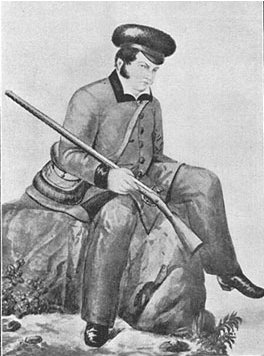
Agustín Vicente Zamorano (1798–1842), was a printer, soldier, and provisional Comandante General in the north of Alta California.

Thomas Oliver Larkin, known later in life as Don Tomás Larkin, was an American diplomat and businessman.

The history of California can be divided into the Native American period, the European exploration period (1542–1769), the Spanish colonial period (1769–1821), the Mexican period (1821–1848), and United States statehood. California was one of the most culturally and linguistically diverse areas in pre-Columbian North America. After contact with Spanish explorers, many of the Native Americans died from foreign diseases. Finally, in the 19th century there was a genocide by United States government and private citizens, which is known as the California genocide.
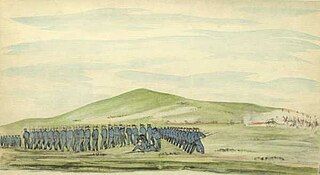
The Siege of Los Angeles, sometimes known as the Battle of Los Angeles, was a military response by armed Mexican civilians to the August 1846 occupation of the Pueblo de Los Ángeles by the United States Marines during the Mexican–American War.
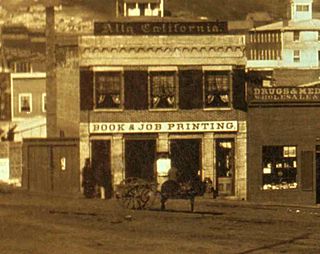
The Alta California or Daily Alta California was a 19th-century San Francisco newspaper.

The Oregon Spectator, was a newspaper published from 1846 to 1855 in Oregon City of what was first the Oregon Country and later the Oregon Territory of the United States. The Spectator was the first American newspaper west of the Rocky Mountains and was the main paper of the region used by politicians for public debate of the leading topics of the day. The paper's motto was Westward the Star of Empire takes its way.

The history of newspapers in California dates back to 1846, with the first publication of The Californian in Monterey. Since then California has been served by a large number of newspapers based in many cities.
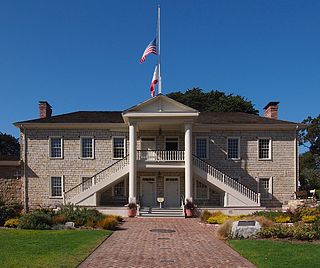
Colton Hall is a government building and museum in Monterey, California, United States. It was built in 1847-49 by Walter Colton, who arrived in Monterey as the chaplain on Commodore Robert F. Stockton's vessel. He remained and was named as Monterey's first alcalde (mayor) in the American Period. Colton Hall originally contained rooms downstairs for a public school and government assembly hall upstairs. It was the site of California's first constitutional convention in 1849.
Isaac Stockton Keith Ogier was a United States district judge of the United States District Court for the Southern District of California.

The following timeline traces the territorial evolution of California, the thirty-first state admitted to the United States of America, including the process of removing Indigenous Peoples from their native lands, or restricting them to reservations.
Rancho Paso de Robles was a 25,993-acre (105.19 km2) Mexican land grant in present-day San Luis Obispo County, California given in 1844 by Governor Manuel Micheltorena to José Pedro Narváez. The name means "Pass of the Oaks". The grant encompassed present-day Paso Robles and Templeton.
Doctor Robert Baylor Semple (1806–1854) was a 19th-century California newspaperman and politician.

The Conquest of California, also known as the Conquest of Alta California or the California Campaign, was an important military campaign of the Mexican–American War carried out by the United States in Alta California, then a part of Mexico. The conquest lasted from 1846 into 1847, until military leaders from both the Californios and Americans signed the Treaty of Cahuenga, which ended the conflict in California.
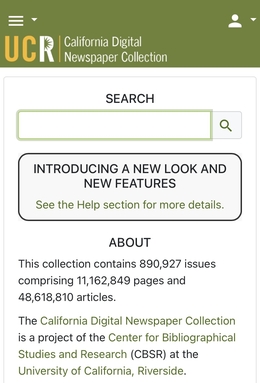
The California Digital Newspaper Collection (CDNC) is a freely-available, archive of digitized California newspapers; it is accessible through the project's website. The collection contains over six million pages from over forty-two million articles. The project is part of the Center for Bibliographical Studies and Research (CBSR) at the University of California Riverside.

The interim government of California existed from soon after the outbreak of the Mexican–American War in mid-1846 until U.S. statehood in September, 1850. There were three distinct phases: